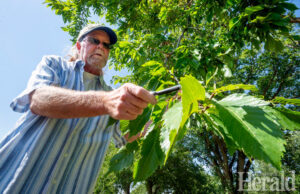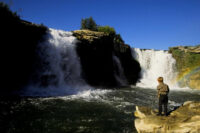First cases of Dutch Elm Disease in province found in Lethbridge
By Lethbridge Herald on August 27, 2020.
 City urban forestry technician Lindsay Bell points out some of the features of an elm tree in a northside park, as forestry staff confirmed two trees were recently discovered to be infected with Dutch Elm Disease. Herald photo by Ian Martens @IMartensHerald
City urban forestry technician Lindsay Bell points out some of the features of an elm tree in a northside park, as forestry staff confirmed two trees were recently discovered to be infected with Dutch Elm Disease. Herald photo by Ian Martens @IMartensHeraldTim Kalinowski
Lethbridge Herald
tkalinowski@lethbridgeherald.com
The City of Lethbridge has the first two confirmed cases of Dutch Elm Disease in the province of Alberta.
City forestry technicians noted the tell-tale signs in two trees in north Lethbridge in early August. When samples were sent off for testing at federal and provincial labs, they came back positive.
The trees have since been cut down and destroyed to reduce the risk of nearby spread.
Dutch Elm Disease (DED) has been circulating in urban forests in North America since 1928, and has caused the mass die-off of these stately shade trees as the condition spreads steadily through the continent. The disease is spread by tiny elm bark beetles who act as carriers, but the root cause of the disease is a fungus which gets into open wounds in the trees and spreads through the branches. Both Montana and Saskatchewan have had the disease for a number of years.
City Parks manager Dave Ellis said it is unknown how Dutch Elm Disease came to be in Lethbridge’s urban forest, but is likely due to some local citizens not following the rules on how to prevent the spread despite decades of prominent public messaging over the issue.
“This is a deadly disease that is spread by fungus carried by the elm bark beetle,” he explained. “This is currently the only known location in Alberta or British Columbia. Our two Western provinces have been the last place in Canada to be DED free. Lethbridge has been part of Society to Reduce Dutch Elm Disease since its inception.
“A few regulations are in place that have contributed to the successful prevention of Dutch Elm Disease in the past. They include a pruning ban on all elms between April 1 and Sept. 30. It is also illegal to use, store, sell or transport elm firewood. And it is illegal to purchase or transport elm trees from infected areas.
“We don’t know, and we will probably never know, how this disease arrived in the middle of Lethbridge, but probably one of these regulations were not followed.”
Lethbridge has just under 6,000 elm trees which are all now at risk representing about 12 per cent of the city’s total urban forest, said Ellis, and the provincial and federal government will likely become directly involved in trying to prevent the spread of the disease outside of the city and may, in effect, impose a total elmwood bubble, or quarantine, over the city.
This may lead to additional costs for monitoring and enhanced testing on local elms which the City will have to bear, at least in part.
“People with elm trees on private property are asked to confirm they have an elm tree,” stated Ellis. “And then to monitor it, if they do, for signs and symptoms. The most common sign and symptom this time of year includes flagging, (sudden wilting and yellowing of leaves and quick onset of desiccation, or drying out, in leaves on branches, or on other parts of the tree). Parks staff are available to help if there is suspicion or confusion as to whether the tree is in fact infected. We ask homeowners to contact us through the 311 system.”
Ellis said city council has already set aside contingency funds to prepare for such an eventuality, but Ellis still expressed his sadness that those contingency measures will now have to be enacted in his time as Parks manager.
“The efforts to control Dutch Elm Disease,” he explained, “and keep it out of the province, have been going on for 20 or 25 years, and it has been a very active effort, and very deliberate, on the part of municipalities in the province of Alberta. Because it has been devastating where this has showed up. It is very costly, and totally affects the makeup of the urban forest when it has shown up.”
Ellis said the City has launched an aggressive effort to observe all elm trees on public lands in the urban forest to seek out any other possible trees infected with the disease. He emphasized the best way for citizens to help with this effort is for homeowners to examine their own trees and for residents to follow the regulations laid out on the pruning, storage and import of elmwood.
Follow @TimKalHerald on Twitter
-1




